There are a series of stages to coming down from a festival. After the hectic rush of travel there are the several days of catching up on lost sleep and picking up the threads of your life again, then once a semblance of order has been regained there’s that few weeks of emptiness. Your life will never be the same again, it’s all so mundane.
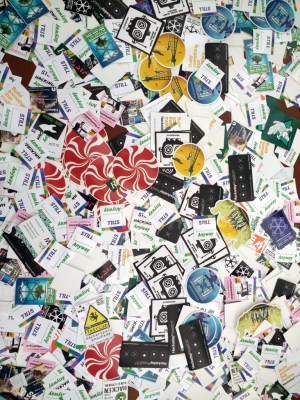
It’s now a couple of weeks since the SHACamp 2017 hacker festival in the Netherlands was in full swing, and the write-up below has slowly taken shape over that time amid the other work of being a Hackaday scribe and editor. It’s early morning here in Southern England as I write this, so on the equivalent day while I was at SHACamp at this time I would have been carrying a large pack of stickers for distribution on the swapping table through the rising sunlight of a camp still largely asleep after the previous night’s revelry. Past our German and Dutch immediate neighbours, down the ramp from the dyke, the cardboard tent depot on my left and the food court on my right, to the information tent. Greet the bleary-eyed volunteer at the end of their graveyard shift, and spread plenty of Hackaday and Tindie stickers on the table for the masses. And then? Find a coffee, and sally forth into the field for another day among one of the most stimulating communities on Earth. My community. Your community.
The sticker table is a good place to start if you wish to get a handle on a large hacker camp. On it you will find the logos of a cross-section of the diverse organisations and groups present. There are a few commercial ones like my Jolly Wrenchers and Tindie the puppy, there are some from voluntary organisations or interest groups, but mostly they are the logos of a continent’s — even the wider world’s in some cases — hackspaces and makerspaces. Here you see the breadth of the attendees, as the logos of spaces from thousands of miles away you’ve never encountered before mingle. This isn’t quite a global gathering, but there is a sense of global community around it.
How Do You Describe a Hacker Camp?
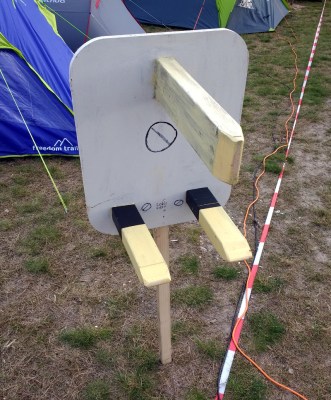
So before I take you through my experience of SHA, it’s best to start by describing a hacker camp in more general terms. When I’m describing a camp like SHA to the kind of people who don’t read Hackaday, I put it as similar to the music festivals they are used to but without the bands. Instead the audience provides the entertainment through the work they bring to the event or do at the event, and through a comprehensive program of talks and lectures. Oh — and this is the bit that makes their eyes open wide — every structure on site from the smallest one-man tent to the largest marquee has mains power and high-speed Internet. Sometimes people grasp what SHA is from this description, sometimes they don’t.
Different groups, be they individual hackspaces, people from a particular country, or other special interest groups, congregate in villages, collections of tents, marquees, and gazebos in which they set up whatever cool stuff they’ve brought along. My tent with its Hackaday flag was in a village composed of a mix of British hackspaces up on the dyke, which [Michael] from MK Makerspace had marked with a sign consisting of a huge BS1363A mains plug. More than one person pointed out it would have been better lying flat on the ground with pins in the air, ready to catch an unwary Monty Python foot.
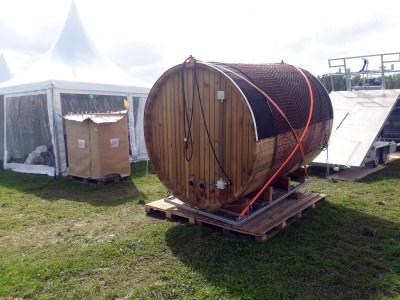
In the British village it’s fair to say we had more of a living space than an exhibition space, but for many of the other villages a huge effort had clearly gone into making them a showcase — in some cases an extravaganza — that sums up the group in question. Usually that includes showpiece hacks and pieces of work, but sometimes national and regional villages bring a local flavour. For example the Italian Embassy was serving pasta to a long and eager queue, a group of Finns had brought along a mobile sauna, while the Belgians had plenty of bottled beer. Maybe the Brits should bring along some Marmite next time, that’ll show ’em!
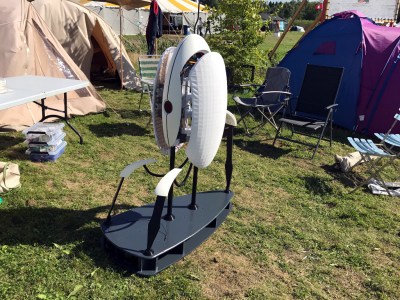
When nearly four thousand people descend upon a single place for this kind of activity, as you might imagine the place in question needs to be pretty large. The SHA site was Scoutinglandgoed Zeewolde, a huge outdoor Scout camp that would probably take most people in the region of a quarter-hour to walk from one end to the other. It was divided into fields named for famous and influential people in the hacker pantheon, from [Elizabeth Alexander] to [Konrad Zuse], and the different fields each had their own flavours. Some people like a quiet area of the outlying fields, others brought their families to the extremely well-equipped family fields, and still more prefer to party all night amid loud techno music, artificial smoke, and experimental pyrotechnics and lighting effects in the noisy fields.
With such a huge gathering of our community on hand, it’s difficult to see everything on the field, let alone report it in one place. It’s thus best to pass on a selection of impressions of the community side of the event, before taking a look at some of the highlights of the talk schedule.
Walking Around the Field
![Never mind backseat drivers, [Lucy Fauth] and [Jana Marie Hemsing] are armchair drivers!](https://hackaday.com/wp-content/uploads/2017/08/chaoswest-armchair.jpg?w=300)
Other builds that caught everyone’s attention were the TkkrLab Portal turret (Google Translate link), and the pyrotechnics and what are best described as post-apocalyptic vehicles courtesy of Area 42 Industries. Beyond that it was a case of dropping in to the various villages scattered around the site, the food hacking village, the multirotor fliers, and many more.
The hardware hacking zone would probably have attracted many Hackaday regulars, it was tucked away in the Belgian village. There was a regular surface mount and reflow soldering course underway, as well as one or two kit vendors from within our community offering their wares. A bring-and-swap for people’s failed projects seemed mostly to have produced piles of surplus electronic components, but maybe I turned up too late to catch the good stuff.
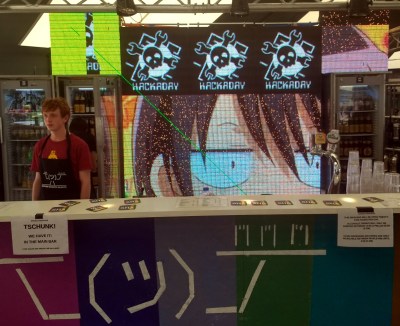
The SHA people themselves had provided several bars as well as the food court, from the noisy central bar to a quiet bar out on the periphery. My top tip when it comes to hacker camp food: go for the vegan truck even if you aren’t a vegan, you’ll get better ingredients, and the queue is always shorter. Meanwhile the central bar’s addressable pixel screen was a theatre of combat as various individuals and villages fought it out for control of what was displayed. Mid afternoon, buying a beer for a laptop-toting member of a British hackspace brought a speedy set of Wrenchers behind the bar, but he would have had no chance in the evening as the big guns rolled out their finest efforts.
Meanwhile, On Stage…
The fun and frivolity is of course only half of these events, there is also a comprehensive program of lectures and talks which thanks to the CCC Video Operation Center team you can watch for yourselves without ever having been there.
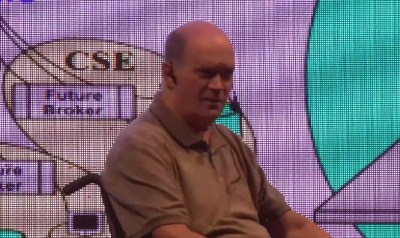
The big ticket was probably the NSA whistleblower [Bill Binney]’s chilling description of the big data collection activities of intelligence agencies, “How the NSA tracks you“, which certainly caught the attention of some of the traditional media. Then there was [Malavika Jayaram]’s unravelling of the Indian government’s sinister biometric ID program, “Biometric ID cards by the billion“.
A security themed talk more in the hardware vein came from [Willem Westerhof], whose “How an intern hacked the powergrid” detailed a distributed attack on the power grid using vulnerabilities in solar power controllers. The one that had a bit of a buzz afterwards on our campsite though was “How hackers could have hacked all Dutch elections since 2009“, from [Sijmen Ruwhof], an exposé of the Netherlands electoral system that those who were at the lecture were talking about mainly for the comprehensive takedowns from real election volunteers in the questions (in the video, about at 42:10). Ouch!
Closer still to home for Hackaday readers were [Axel Theilmann]’s “The Hackeboy Handheld Game Console” with its presentation slides that broke the static mould, [Tal Melamed]’s “Hacking BLE Smart Devices“, and [Dominic Spill] and [ktemkin]’s “FaceDancer 2.0“, on USB hacking. Mechanical projects made an appearance in the talks, courtesy of [Russell]’s talk on “How I made my diesel motorcycle“, which covers not one but two motorcycles, one with a little Kubota twin and the other with a VW 1.9 litre car unit. However it’s fair to say that this was more of a software event than a hardware one on the stages.
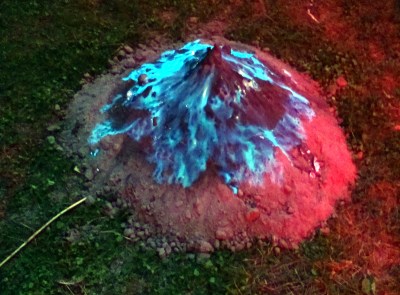
Of interest more for its question session than the talk itself was [Lazerbeamwizard]’s talk on being a modern-day hobo, “Exploiting The North American Railways“. You might not want to do it yourself, but if you’ve been fascinated by the YouTube videos of freight-hopping then here’s your chance at a first-hand account. And if music is your thing then be sure to take a look at [Matt “Gasman” Westcott]’s “Zero to chiptune in one hour“, in which he takes an audience recommendation and composes it in a ZX Spectrum tracker before your very eyes. I must admit to having been a party to the choice of music there, his hackspace were trolling him in the expectation that another audience member would make a saner choice, and nobody did. He made an excellent job of it, but sorry [Matt]. And finally in a piece of blatant self-promotion, should you ever think about putting one of your electronic kits on the market, I gave a follow-up to the series I wrote here last year: “From Project To Kit“.
Never Long Enough
So that was it, SHACamp 2017. Not enough days, but these camps never are. I had a blast, and I offer my sincerest thanks to both the many people behind the event, and to all the people in our community who made me welcome, shared a beer or two and some popcorn with me, talked about electronics, cider, Hackaday, canoeing, radio, British mains connectors, and a host of other fascinating things. You are the community we are a part of, and it is great to spend time with you.

It’s worth saying a few words about the location for SHACamp 2017. Flevoland is the Netherlands’ newest province, and its southern section, Flevopolder, is its most recent part having only been reclaimed from the depths of the Ijsselmeer at the end of the 1960s. It might not have the most exciting of reputations because it is very flat and open even by Dutch standards and everything’s still quite new. But hailing myself from rural England and being familiar with our Fenland I found it to be a pleasant enough place with plenty of greenery and the same wide skies captured by the Dutch master painters centuries ago. I can think of no other gathering in this sphere during which I might have had a relaxing paddle up the shoreline in a canoe with a friend, I’d definitely come back here.
The successor to SHACamp 2017 in the Netherlands will be in 2021, so meanwhile the next comparable European event will be next summer’s EMF Camp closer to home for me in the West of England. I hope I’ll see you there.

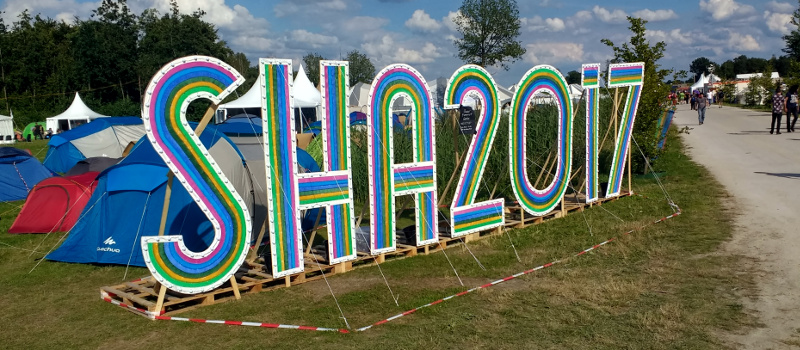














“You might not want to do it yourself, but if you’ve been fascinated by the YouTube videos of freight-hopping then here’s your chance at a first-hand account. ”
Aside from the legality, there’s the danger. Trains aren’t toys.
I was just heading out the door to start my train-surfing adventure when I read your warning Ostracus. Thank heavens for your note and advice — it had never occurred to me there was a risk, and I’ve now decided to stay at home and continue with my quest to stuff unusual items into wall sockets.
Don’t do it! Speaking from experience in stuffing unusual items into wall sockets eventually you’ll hit upon something that will shock the beejezus out of you.
+1
If you watch the talk, he makes that point rather forcefully.
Wow, what an excellent write-up of what there is to SHA. Not only did you describe the concept quite well, you also managed to quite comprehensively describe the programme!
I’d be happy if you left The Black Death/Marmite at home though. Bring sharp cider or Eton mess.
Mmmm. Marmite. Great writeup, too.